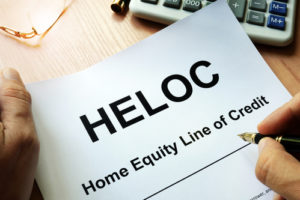 By Alyssa Furtado, RateHub.ca
By Alyssa Furtado, RateHub.ca
Special to the Financial Independence Hub
A home equity line of credit (HELOC) is a convenient way to access the value in your home. You might have seen commercials on TV or been offered one by your mortgage agent. Not only can you get a much lower interest rate than you can with an unsecured line of credit, you can also be approved for a sizeable loan. It’s tempting to have quick access to a lot of money, but is a HELOC right for you?
A HELOC is a secured line of credit that uses your home as security. As with a mortgage, the money you borrow is secured by your home. In Canada, as long as you can show that you can carry the debt, you can borrow up to 65% of the value of your home, provided you keep at least 20% of the value as equity.
For example, if your home is worth $1 million and you owe $400,000 on your mortgage, you can borrow up to $400,000 against your home ($1 million x 80% = $800,000 – $400,000 owing = $400,000).
There are many upsides to getting a HELOC. Depending on the value of your home, you can potentially borrow a large amount of money. Interest rates on HELOCs are significantly lower than on unsecured lines of credit (typically about prime + 0.5%). You can take out money or repay it at any time without penalty. And you can go up to 25 years before you have to pay back what you’ve borrowed.
One of the most appealing HELOC features is that the minimum monthly payment is just the interest that’s accrued. Using a HELOC calculator on that $400,000 line of credit example above, the monthly payment at today’s best HELOC rate of 3.7% is just $1,233. The minimum monthly payment on a traditional line of credit is typically 2% of the outstanding balance: $8,000 on a $400,000 balance. Even a traditional mortgage would require a much higher monthly payment. This feature alone is a big part of why HELOCs are so appealing.
Possible downsides of HELOCs
However, HELOCs also have their downsides.
Because the minimum monthly payment on a HELOC is just the interest, it can feel like it doesn’t cost you much to borrow money. But when you don’t repay the principal, your costs over the long run are actually much higher than with a traditional loan.
Let’s look at an example comparing a regular $50,000 loan with a rate of 4.7% repaid monthly against borrowing $50,000 at 3.7% from your HELOC repaid in a lump sum at the end the loan term.
If you pay the loan over five years, your monthly payment will be $936.83 and you’ll pay $6,209.80 in interest over that time.
If you carry the $50,000 balance in the HELOC over five years, your monthly interest payment at today’s best HELOC rate of 3.7% is only $154 per month. But you’ll pay $9,240 in interest over 10 years. Even though the rate on the HELOC is lower, you’ll still pay nearly 50% more in interest because you didn’t make any regular monthly payments. So it will actually cost you a lot more money in the long run.
There are other drawbacks to HELOCs as well. Because they’re technically a second mortgage, you’ll need a real estate lawyer to help you get set up. Lawyer fees range from $800 to $1,200.
Many lenders will also require you to get an appraisal on your home to prove its value. A typical appraisal will cost around $300, making the total cost of setting up a HELOC anywhere between $1,100 and $1,500.
HELOCs are also affected by interest rate changes. If the Bank of Canada raises interest rates, your cost of borrowing will go up right away. Every quarter-point interest rate hike raises your monthly payment.
But the biggest downside is that HELOCs are secured by your home. If you default, your lender can use power of sale to take your house from you. You may have to repay the HELOC when you sell your home, limiting the amount of money you can put toward the purchase of your next home.
When a HELOC may be right for you
So, is a HELOC right for you? It may be, if you’re well prepared to handle the credit and you’re comfortable with the risks involved. A HELOC might be right for you if:
- You have room in your budget to pay down some principal every month in addition to the monthly payments.
- Your finances are in good shape: you have no trouble making your monthly mortgage payments, paying your bills, and saving some money each month.
- You’ll still be able to make your monthly payments if interest rates go up by a few percentage points.
- You want to use the money to make improvements that will add value to your home, such as finishing a basement. Your realtor can help you calculate the return on investment of home improvement projects to decide if it’s worthwhile.
- You’re refinancing a moderate amount of higher-interest debt that you’re managing well and can continue to pay off comfortably, even without refinancing.
- You’re willing to accept the risk of losing your home in the event you can’t make your payments.
A HELOC may not be right for you if:
- Home prices in your area are falling or unstable. You could end up owing more on your home than it is worth.
- You want to use the money to get something you can’t afford with savings, such as a new car.
- You’re looking for a way to do a better job of keeping up with your bills.
- You need money to start a business; there are other ways to access capital without risking your home.
- You’re using it to refinance a large amount of credit card debt.
If you’re considering a HELOC as a way to solve your financial problems, look elsewhere. If you’re living beyond your means, taking out a larger loan is only delaying the inevitable. A HELOC is a mortgage and you can lose your home if you don’t make your payments. It’s difficult to swallow your pride, but you’ll be much better off in the long run if you make lifestyle changes instead.
If your debt is out of control and you’re considering a HELOC as a way to refinance it, you may be able to get a better deal through a consumer proposal without having to risk your home. A licensed insolvency trustee can help you understand your options.
But if your budget’s in good shape, a HELOC may be able to help you make smart improvements to your home or refinance debt that you were already managing well.
The bottom line
For responsible borrowers, a HELOC is a good financial tool that allows you to access money when you need it and repay it on your own terms. But there are risks associated that raise the stakes on ordinary loans.
 Alyssa Furtado is a passionate entrepreneur, financial expert, digital marketer and educator, and founder of Ratehub.ca, a website that compares mortgage rates, credit cards, high-interest savings accounts, chequing accounts, and insurance with the goal to empower Canadians to search smarter and save money.
Alyssa Furtado is a passionate entrepreneur, financial expert, digital marketer and educator, and founder of Ratehub.ca, a website that compares mortgage rates, credit cards, high-interest savings accounts, chequing accounts, and insurance with the goal to empower Canadians to search smarter and save money.


